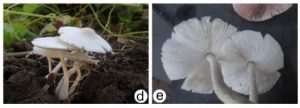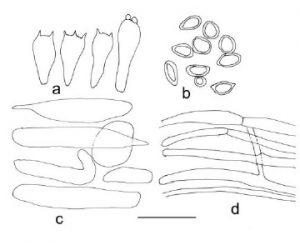Leucocoprinus cepistipes (Sowerby) Pat. [as ‘cepaestipes’], J. Bot., Paris 3: 336 (1889) Index Fungorum number: IF 102263
Synonymy: Leucocoprinus cepistipes f. macrosporus Migl., Boll. Assoc. Micol. Ecol. Romana 3(nos 6–7): 18 (1986)
:Leucocoprinus cepistipes var. pseudofarinosus Raithelh. [as’caepestipes’], Nueva Flora Micológica Argentina (Stuttgart): 524 (2004)
Pileus 2.5–5.3 cm broad, expanded, convex, white, granulated, powdery, subumbonate, margins serrated or rimose. Gills purely white, unequal, free and white powder dusted all over the surface. Stipe 4 to 11 cm long, upto 0.6 cm broad white, broad at the base.
Basidiospores 6.4–9.6 × 4.8–5.6 μm, avL=8.0, avW=5.2, Q=1.3–1.92, thick walled, ellipsoid, smooth, apiculated, hyaline. Basidia 16.0–32.0× 8–11.2 μm clavate, hyaline. Sterigmata 2–4 in number, 1.6 to 3.2 μm long. Pileipellis elements 4.8 to 16 μm wide hyaline, smooth walled, inflated. Stipe hyphae hyaline, branched, septate, clamp connections not found, 1.6 to 14.4 μm wide.
Distribution: Earlier reported from Argentina and India.
Materials Examined: India, Jammu & Kashmir, Jammu, R.S Pura, coprophilous, caespitose, 6 Jul 2015, Roshi Sharma & Y.P. Sharma, HBJU 420.
Notes: The current specimen was reported from Punjab, India (Kaur et al. 2015) but not yet known for Jammu & Kashmir, thus constituting a new addition for the State.
FIGURE. d Basidiocarps of Leucocoprinus cepistipes blooming on cattle dung. e Undersurface view of Leucocoprinus cepistipes showing powdery dust all over the surface.

FIGURE. Leucocoprinus cepistipes a) basidia b) basidiospores c) pileipellis elements d) stipe context hyphae. Scale bars: a-d = 15 μm.

